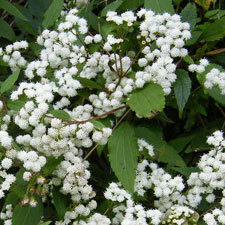 Mistflower
Mistflower
Common name: Mistflower
Botanical name: Ageratina riparia
Management category: Sustained control - Rule 5a applies
Originally from Mexico and the West Indies. It was introduced to New Zealand as an ornamental species and was recorded as naturalised in 1931.
Why is it a pest?
- Grows very densely and overtops groundcovers, is long-lived, quick maturing, and produces a large number of highly viable, well-dispersed seeds.
- Forms dense colonies that prevent native species establishing.
- Drooping stems can also take root in wet sites when they touch the ground.
- Tolerates deep shade and damp, damage, grazing, salt and most types of soil.
- It can be poisonous so normally avoided by livestock.
Where is it found?
- Invades damp forest and margins, intact and disturbed bush, light gaps, shrublands, wetlands, stream banks.
- Seeds mostly dispersed by wind and also by water, gravel, and in mud sticking to clothing, machinery, animals etc. Existing plants spread by creating layers of trailing branches.
What does it look like?
- Erect or sprawling many-stemmed plant less than 1m tall, with a perennial fibrous rootstock.
- Stems are usually purple and are covered in purple-striped non-sticky hairs, become woody with age and occasionally die back in winter.
- Clusters of small white flowers (August to January) are followed by black 5-angled seeds.
What are the rules?
Sustained control
Sustained Control pests are well established in the region and preventing the spread is no longer a realistic objective. Management focuses on reducing general impacts of the pest. Landowners/occupiers are responsible for the control of these pest species on their land. Council may enforce control.
Under rule 5a of the RPMP landowners/occupiers must destroy this pest if required by a written direction from an authorised person unless a property specific pest management agreement has been agreed and signed between the occupier and the Council.
Criteria to meet Rule 5A include when the species is being actively managed by council, other agency and or community group, on an adjacent property. See the Regional Pest Management Plan 2020-2030 rules for Sustained control pests for more information.
How do you get rid of it?
- Hand-pull – ensure roots are exposed.
- Dig out – ensure roots are exposed.
- Foliar spraying (spring to summer) when in flower.
CAUTION: When using any herbicide or pesticide, PLEASE READ THE LABEL THOROUGHLY to ensure that all instructions and directions for the purchase, use and storage of the product, are followed and adhered to.
Read more on pest control advice, information and regulations.
Images






